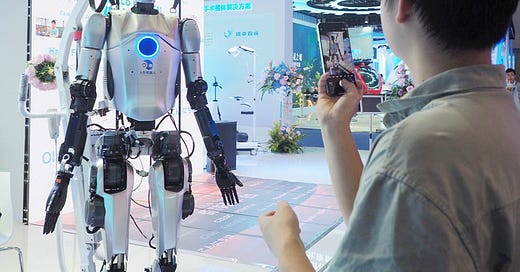China Holds 63% of Global Humanoid Robot Supply Chain
Morgan Stanley’s recent report, Humanoid 100: Mapping the Value Chain of Humanoid Robots, has shed light on the remarkable rise of China within the global humanoid robot industry.
Holding 63% of the global humanoid robot supply chain, China’s contribution spans critical hardware, integrated systems, and innovation ecosystems.
China’s Key Role in the Humanoid Robot Industry
According to Morgan Stanley, China’s dominance is most pronounced in the production of core hardware components—or the “Body” segment—where Chinese companies control 45% of the supply chain.
Major players such as Jiangsu Hengli Hydraulic and Ningbo Yunsheng have become integral suppliers of actuators, rare earth magnetic materials, and other essential hardware.
This is complemented by China’s commanding control of 90% of global rare earth processing, a crucial input for motors and actuators.
China’s strength in the humanoid robot sector stems from its mature manufacturing ecosystem, extensive supply chain networks, and policy support.
Startups such as Fourier Intelligence and Ubtech Robotics have capitalized on these advantages, building world-class capabilities in sensors, batteries, and integrated systems.
Morgan Stanley highlights that 73% of companies and 77% of integrators involved in humanoid robot production are based in Asia, with China accounting for 56% of these firms. This geographic concentration underscores the region’s strategic importance and positions China as the linchpin in the humanoid robotics industry.
Breaking Down the Humanoid Robot Value Chain
Morgan Stanley divides the humanoid robot industry into three key segments: Brain, Body, and Integrator.
1. The Brain: AI Chips, Software, and Semiconductors
The “Brain” segment encompasses AI algorithms, semiconductors, and software that enable robot autonomy and intelligence. Companies like NVIDIA, Microsoft, and Google dominate this field, focusing on generative AI models, digital twins, and high-performance computing chips.
Chinese companies such as Baidu and Horizon Robotics are rapidly emerging as leaders in vision-based AI chips and algorithms, helping bridge the technological gap with Western firms.
These AI advancements enhance the scalability, precision, and long-term stability of humanoid robots, setting the stage for mass production and market penetration.
2. The Body: Hardware Components and Physical Systems
Morgan Stanley identified 64 companies globally in the “Body” category, with many Chinese firms leading in areas such as actuators, sensors, and lithium-ion batteries. Major contributors include:
Actuators: Companies like Jiangsu Hengli Hydraulic and Zhejiang Shuanghuan Driveline supply essential components for movement, with Tesla’s Optimus robot incorporating 28 actuators to achieve 50 degrees of freedom.
Sensors: Hesai Technology, a key supplier of LiDAR and visual sensors, competes with industry giants like Sony.
Batteries: CATL (Contemporary Amperex Technology) plays a crucial role in providing cylindrical lithium-ion batteries, essential for power management in humanoid robots.
These components form the physical infrastructure, enabling humanoid robots to mimic human movement and interact with their environment.
Keep reading with a 7-day free trial
Subscribe to China Innovation Watch to keep reading this post and get 7 days of free access to the full post archives.


